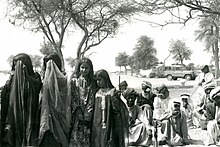
Back إماراتيون Arabic الشعب الاماراتى ARZ ایمارات خالقی AZB Emiratíes Spanish اهالی امارات Persian Orang Emirat ID საამიროელები Georgian Emiratski Arapi Serbo-Croatian Emiratier Swedish Waemirati Swahili
الإمَارَاتِيُّون | |
|---|---|
 | |
 | |
| Regions with significant populations | |
c. 1,150,000[1] | |
| 26,760[2] | |
| 22,608[3][2] | |
| 18,978[2] | |
| 18,046[4][2] | |
| 17,161[5][6] | |
| 9,558[2] | |
| 7,954[2] | |
| 4,415[4][7] | |
| 3,292[2] | |
| 2,076[2] | |
| Languages | |
| Arabic (Gulf, Emirati, Shihhi, Modern Standard) · English · Kumzari[8] · Balochi[9] · Achomi[10][11] · Swahili[12] | |
| Religion | |
| Sunni Islam (90%), Shia Islam (10%)[13] | |
| Related ethnic groups | |
| Afro-Emiratis, Emirati Americans, Other Arabs | |
The Emiratis (Standard Arabic: الإماراتيون; Gulf Arabic: الإماراتيين) are the native citizen population of the United Arab Emirates. Within the UAE itself, they number approximately 1.15 million.[14]
Formerly known as the Trucial States, the UAE is made up of seven emirates, each of which has a ruling family. Abu Dhabi was home to the Bani Yas tribal confederation; Dubai was settled in 1833 by an offshoot of the Bani Yas, the Al Bu Falasah; Sharjah and Ras Al Khaimah are the home to the Al Qasimi or Qawasim; Ajman to the Al Na'im, Umm Al Quwain to the Al Ali and Fujairah to the Sharqiyin.[15][16][17][18]
The Emiratis represent a diverse population with various ethnic, cultural, and tribal backgrounds. While united under the umbrella of Emirati citizenship, they encompass a range of ancestral origins, including Arabian, Persian and North African heritage.[19][20] This diversity is rooted in historical interactions, migrations, conquest, and trade connections that have shaped the demographic landscape of the UAE.[21][19][22][23] Emirati Arabic and English serve as the primary languages of communication amongst the Emirati populace. However, other languages such as Achomi, Balochi, and Swahili are also spoken among certain minority communities.[12]
Islam, being the state religion of the UAE, plays a central role in Emirati society, serving as a guiding force in daily life, governance, and cultural expression. The construction of mosques, observance of religious rituals, and adherence to Islamic principles underscore the spiritual and moral foundations of Emirati identity.[24] Emiratis are all Muslims, approximately 90% of whom are Sunni while the remaining 10% are Shia.[25] Different Islamic schools of thought are followed by the Sunni Emiratis, with the Bani Yas of Abu Dhabi and Dubai traditionally adhering to the Maliki school of Islamic jurisprudence.[26] The emirates of Sharjah, Umm al-Quwain, Ras al-Khaimah, and Ajman following the Hanbali school, and Fujairah adhering to the Shafi'i school.[27]
- ^ MOHNBLATT, DEBBIE (24 October 2022). "With Abu Dhabi art event, UAE celebrates status as culture hub". The Jerusalem Post | JPost.com.
- ^ a b c d e f g h "United Nations International Migrant Stock".
- ^ Canada, Government of Canada, Statistics (25 October 2017). "Immigration and Ethnocultural Diversity Highlight Tables – Immigrant population by place of birth, period of immigration, 2016 counts, both sexes, age (total), Canada, 2016 Census – 25% Sample data". 12.statcan.gc.ca. Retrieved 27 May 2018.
{{cite web}}: CS1 maint: multiple names: authors list (link) - ^ a b "Emiratis Migrating from UAE".
- ^ "peoplemovin - A visualization of migration flows".
- ^ "Country-of-birth database". Organisation for Economic Co-operation and Development. Archived from the original on 17 June 2009. Retrieved 24 October 2010.
- ^ "Australia is keen to promote Islamic finance". Khaleej Times. 18 June 2010. Archived from the original on 29 November 2014. Retrieved 22 November 2014.
- ^ The Kumzari Dialect of the Shihuh Tribe
- ^ Culture Production in the Post-Maritime Gulf Metropolis
- ^ Iranian and Arab in the Gulf : endangered language
- ^ The Lāri language
- ^ a b Cite error: The named reference
:7was invoked but never defined (see the help page). - ^ US State Dept 2022 report
- ^ Mohnblatt, Debbie (24 October 2022). "With Abu Dhabi art event, UAE celebrates status as culture hub". The Jerusalem Post | JPost.com.
- ^ "Al Maktoum". 15 June 2013. Archived from the original on 15 June 2013. Retrieved 15 March 2024.
- ^ Edmonds, James (8 September 2017). The House of Nahyan: The Story of an Arabian Dynasty. Independently published (published 8 September 2017). ISBN 978-1717803184.
- ^ "The UAE: A Brief History, Part 3 The Multi-Tribal Qasimi Empire". AlShindagah.com. Retrieved 15 March 2024.
- ^ Heard-Bey, Frauke (2005). From Trucial States to United Arab Emirates : a society in transition (1941-). London: Motivate. ISBN 978-1860631672. OCLC 64689681.
- ^ a b Cite error: The named reference
:5was invoked but never defined (see the help page). - ^ "Researchers find genetic 'fingerprints' of ancient migrations in modern-day United Arab Emirates". University of Birmingham. Retrieved 7 April 2024.
- ^ Cite error: The named reference
:4was invoked but never defined (see the help page). - ^ Cite error: The named reference
:2was invoked but never defined (see the help page). - ^ Cite error: The named reference
:6was invoked but never defined (see the help page). - ^ Dhabi, NYU Abu. "Religion and Spirituality". New York University Abu Dhabi. Retrieved 1 April 2024.
- ^ Cite error: The named reference
:8was invoked but never defined (see the help page). - ^ "بنو ياس". Archived from the original on 24 September 2015. Retrieved 22 February 2014.
- ^ Rubin, Barry M. (2010). Guide to Islamist Movements. M.E. Sharpe. ISBN 978-0-7656-4138-0.
© MMXXIII Rich X Search. We shall prevail. All rights reserved. Rich X Search